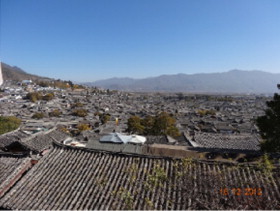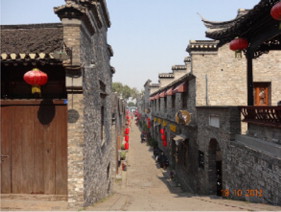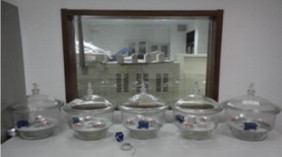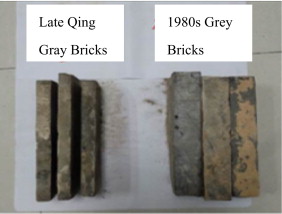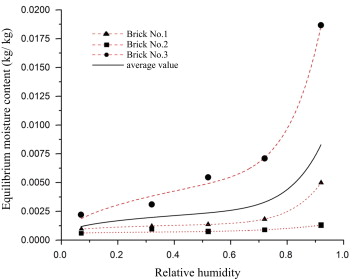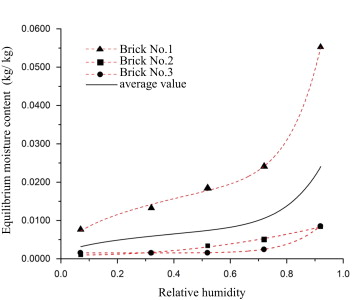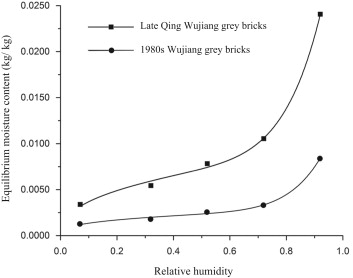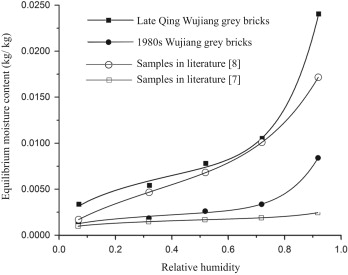Abstract
Grey brick is a key material in Chinese traditional architecture. The isothermal sorption curve of grey bricks is one of the basic moisture characteristics for studying the heat transfer of brick building enclosure structures and is also a fundamental parameter of research into the degradation mechanisms of Chinese traditional architecture. In this study, we measure the isothermal sorption curves of Wujiang (Suzhou, China) bricks from the 1980s and the late Qing period, by applying constant relative humidity controlled by saturated salt-water solutions under isothermal conditions. We then present their fitting formulas for humidity bound ranges of 5−92%. The results indicate that samples of the same-area traditional Suzhou grey bricks from different time periods show relatively large differences in their isothermal sorption properties, with the isothermal sorption property values of the late Qing grey bricks about three times those of the 1980s grey bricks.
Keywords
Grey brick ; Periods ; Equilibrium moisture content ; Isothermal sorption ; Suzhou
1. Introduction
Grey brick and green tiles are prominent features of traditional Chinese architecture (see Figure 1 ; Figure 2 ) and are key components of ancient architecture as well. Grey brick is similar to red brick in strength but surpasses it in terms of anti-oxidation, hydration resistance, atmospheric corrosion resistance, and other properties. Therefore, grey bricks have been used as the main material in most traditional Chinese brick constructions to create what we know today as the characteristically Chinese grey brick buildings. There are many grey brick historic buildings in China but over time grey brick masonry features have begun to deteriorate—they crumble, salt out, become covered with fungi, lose strength, etc. Some historic buildings have even suffered structural damage. As a result, studying the degradation mechanism in Chinese brick historic construction plays an important part in the reconstruction and reuse of Chinese traditional buildings (Shi et al ., 2012 ; Li et al ., 2012 ).
|
|
|
Figure 1. Traditional houses in Lijiang, China. |
|
|
|
Figure 2. Traditional houses in Zhenjiang, China. |
In the natural environment, moisture changes in brick masonries can directly or indirectly accelerate their physical, chemical and biological degradation and then also significantly affect the development of their performance degradation. To compare their moisture properties, isothermal sorption curves are drawn from the measured equilibrium moisture content of materials in conditions of different relative humidities. This is one of the basic methods for estimating the extent of moisture change in materials in the natural environment. The isothermal sorption property of brick provides not only the basis for quantitative study of the brick masonries’ degradation mechanism but also the basis for studying and acquiring related transfer coefficients related to the heat transfer process of enclosure structures.
Thus far, researchers in China and abroad have conducted similar experimental studies on various construction materials. For instance, Karoglou et al. (2005) and Moropoulou et al. (2005) studied the isothermal sorption properties of bricks, plasters and stones. Czech scholars Pavlík et al. (2012) conducted research on the isothermal sorption properties of aerated concretes, light-weight and traditional ceramic tiles, a certain type of phase change material, and lime pastes. However, European clay bricks differ greatly from traditional Chinese grey bricks in terms of their composition and sintering process, so their data cannot be used to describe Chinese grey bricks. Domestically, Pei and Chen (1999) , Yan et al. (2003) , and Li et al. (2009) carried out experimental studies of the isothermal sorption properties of materials including cement mortar, plasterboard, concrete, rammed-earth wall, clay brick, and expanded polystyrene (EPS) thermal insulation material, and compared the differences in their isothermal sorption curves. Domestic studies, however, have not elaborated on the origin areas, ages and specific types of the sample bricks, and therefore they cannot provide the necessary statistical support needed to research the degradation mechanism of historic buildings.
The research in this article focuses on grey bricks, the key materials in Chinese historic buildings. We mainly studied the isothermal sorption properties of grey bricks originating from Wujiang (Suzhou, China) and conducted comparative studies of the sorption property differences of various same-batch samples from different years to provide basic characteristics data support for the preservation of brick historic buildings.
2. Experimental method
2.1. Experimental principles
Equilibrium moisture content (EMC) is the moisture content at which a material is neither gaining nor losing moisture under certain environmental air conditions. The EMC, however, is a dynamic equilibrium that changes with relative humidity and temperature. Its definition formula is as follows:
|
|
( 1) |
In the formula, μ refers to the equilibrium moisture content (kg/kg) of the material, m refers to the material mass (kg) after absorbing moisture, and m0 refers to the oven-dry mass of material (kg).
Under isothermal conditions, we used different saturated salt solutions to create different relative humidity environments, thus enabling grey bricks to reach equilibrium status in different environments. We then measured the equilibrium moisture content of the grey bricks. For this purpose, we put the experimental results into formula (2) to acquire the isothermal sorption curve. Formula (2) is found in the equilibrium moisture content curve database of common building materials, developed by the Florida Solar Energy Centre (FSEC) in the United States (Kumaran et al. (1990) ).
|
|
( 2) |
In the formula, a, b, c, and d are experimental constants, and ψ represents the relative humidity.
2.2. Experimental devices
The basic experimental devices include the experimental drying vessel, the photoelectric precision balance (model: MSE324S-000-DU, accuracy: 0.1 mg) and the temperature and humidity recorders (see Figure 3 , measuring instrument type: RTR 53A, accuracy: 0.1 °C/ 0.1%). In the drying vessel, we used a few different saturated salt solutions to create different steady relative humidity environments and we then monitored their temperature and humidity with the recorders. Every dessicator used has a perforated barrier. The samples were placed above this barrier and the spaces above and below the barrier were connected through its perforations. Since temperature and humidity are both driving forces of moisture migration, to reduce the influence of temperature on the equilibrium moisture content, we put the desiccators in 23±1 °C environments where temperatures were controlled by automatic-temperature-control air conditioners.
|
|
|
Figure 3. Experimental drying vessels and automatic temperature and humidity recorder. |
2.3. Experimental process
Based on the standard for hygrothermal performance of building materials and products’ hygroscopic sorption properties (GB/T 201312-2006/ISO 12571:2000), the equilibrium moisture contents of both the late Qing grey bricks and the 1980s bricks were measured in conditions with different relative humidities in isothermal environments, so as to acquire their isothermal sorption curves. We selected three of each kind of brick (see Figure 4 ), and these were cut into smaller pieces (about 2 cm×1 cm×1 cm, weighing 3–5 g). Three small pieces (weighing about 9–15 g in total) were used as test sample specimens of the brick types. We adopted the following steps in the lab: first we put the samples in a 105±5 °C oven until they were fully dried (they are considered fully dried when there is a mass difference of less than 0.1% between two measuring results). After weighing the test samples with a photoelectric precision balance, we put them, one at a time, in a drying vessel with specific relative humidity. The test samples’ balancing masses were recorded when their masses reached equilibrium status (the mass difference between two measurements was less than 0.1%). In the five drying vessels, we used lithium chloride, magnesium chloride, magnesium nitrate, potassium chloride, and potassium nitrate to make the saturated salt solutions, thus creating five different environments with relative humidities of 5±1%, 32±1%, 52±1%, 72±1% and 92±1%, respectively. Specific measured relative humidity data are shown in Table 1 . We used distilled water to make saturated salt solutions and spread Vaseline around the seals of the desiccator lids to enhance sealing and ensure the accuracy and stability of the relative humidity in the desiccators.
|
|
|
Figure 4. Samples. |
| Salt | Formula | Measured relative humidity |
|---|---|---|
| Lithium chloride | LiCl·H2 O | 5±1% |
| Magnesium chloride | MgCl2 | 32±1% |
| Magnesium nitrate | Mg (NO3 )2 | 52±1% |
| Potassium chloride | NaCl | 72±1% |
| Potassium nitrate | KNO3 | 92±1% |
3. Experimental results and analysis
Figure 5 shows the isothermal sorption curves of the 1980s Wujiang brick, sample numbers 1–3. From these curves we can see that their moisture absorption change ranges were respectively 0.00097–0.00495 (kg/kg), 0.00061–0.00133 (kg/kg), and 0.00219–0.01865 (kg/kg) within the range of 5–92% relative humidity. Figure 6 shows the isothermal sorption curves of the late Qing Wujiang brick, numbers 1–3, which show that their moisture absorption change ranges were respectively 0.00768–0.05527 (kg/kg), 0.00154–0.00860 (kg/kg), and 0.00094–0.00836 (kg/kg). In general, the moisture contents of the grey bricks showed exponential increase with increasing relative humidity.
|
|
|
Figure 5. The isothermal sorption curve of 1980s Wujiang grey bricks. |
|
|
|
Figure 6. The isothermal sorption curve of late Qing Wujiang grey bricks. |
From Figure 5 ; Figure 6 we can see that for the isothermal moisture contents of grey bricks, there was a relatively small difference between the 1980s Brick Nos. 1 and 2, while Brick No. 3 differed significantly from the other two. The moisture content of No. 1 was 6.43 times that of No. 2, but 6.61 times that of No. 3 at 91% relative humidity. According to these results, due to the difference of the inner pore structures produced during grey bricks’ sintering process, bricks from the same area and the same batch showed relatively large differences in their isothermal moisture properties. Because the moisture fluctuations of the bricks themselves in natural environmental conditions show an indirect relationship with brick masonry degradation, we can conclude that the relatively large differences among the isothermal sorption curves of bricks will affect the starting point of the performance degradation of same-area bricks in the wall.
Figure 7 compares the average values of the isothermal sorption curves of the 1980s and late Qing grey brick samples. This figure shows that ith different relative humidities, the equilibrium moisture contents of the late Qing grey bricks were between 0.00339–0.0241 (kg/kg) and those of the 1980s were between 0.00126–0.00831 (kg/kg). From this figure, we also see that with the same relative humidity, the equilibrium moisture content of the late Qing grey bricks is about three times that of the 1980s grey bricks. Thus, we can conclude that there are obvious differences between the isothermal sorption properties of same-area grey bricks from different years. Based on the average values of the isothermal sorption curves of the 1980s and late Qing grey brick samples, Table 2 gives the fitting formula and related coefficients of their isothermal sorption curves.
|
|
|
Figure 7. Average value comparisons between the isothermal sorption curves of 1980s and late Qing grey Wujiang bricks. |
| Material | Fitting formula | Related coefficient |
|---|---|---|
| 1980s grey brick | μ =0.00184ψ2.5934 +5.4753E−4ψ0.1385 | R2 =0.9908 |
| Late Qing grey brick | μ =0.00156ψ0.1250 +0.0034ψ2.0194 | R2 =0.9933 |
Figure 8 compares the difference between experimental data from the isothermal sorption curves of the brick samples in two previous Chinese studies (Yan et al., 2003 ), Li et al. (2009) and our studys experimental data. From Figure 8 we can see that data from the first previous study (Yan et al., 2003 ) are close to the equilibrium moisture content curve for the 1980s Wujiang grey bricks found in this study, and so are the data from the second previous study Li et al. (2009) close to the curves we found for late Qing grey bricks. However, these previous study sources (Yan et al., 2003 ) and Li et al. (2009) did not specify the types and years of the sample bricks they used.
|
|
|
Figure 8. Comparison between the 1980s and late Qing grey bricks and the testing results from existing literature (Yan et al ., 2003 ; Li et al ., 2009 ). |
In the field of architectural heritage conservation, performance degradation phenomena such as salting out, dry–wet cycle analysis, microorganism propagation, etc., and heat and moisture analysis of traditional brick structures are influenced mostly by moisture fluctuation in the bricks. Due to the variety of bricks and distinctions between the isothermal moisture contents of different same-batch samples from different years, we recommend that brick isothermal sorption experimental data specify the type and production area of the bricks to establish accurate representation of brick isothermal sorption curves. In addition, the number of samples in isothermal sorption experiments should be increased to improve the statistical significance and accuracy of their experimental data.
4. Conclusion
In this study, we carried out an experimental study of the isothermal sorption properties of Wujiang (Suzhou,China) bricks from the 1980s and the late Qing period. We compared the differences in the isothermal sorption properties between the brick samples and proposed a fitting formula for their isothermal sorption curves. The results can be used as basic data for studying the degradation mechanism of traditional Chinese structures and for coupled heat and moisture analyses of grey brick buildings.
Acknowledgement
This study was supported by the National Science Foundation of China (Grant nos. 51108072 , 51138002). This work was also supported by the Specialized Research Fund for Overseas Returned People Programme of the Ministry of Personnel of the Peoples Republic of China (No.6701000016 ).
References
- Karoglou et al., 2005 M. Karoglou, A. Moropoulou, Z.B. Maroulis, M.K. Krokida; Water sorption isotherms of some building materials; Drying Technology, 23 (2005), pp. 289–303
- Kumaran et al., 1990 Kumaran M.K., Mitalas G.P., Bomberg M.T., 1990. Fundementals of transport and storage of moisture in building Material and components, manual on moisture control in buildings. NRC. Canada.
- Li et al., 2009 K.S. Li, X. Zhang, X. Han, D.M. Zhu; Experimental research of isothermal sorption curve of building materials; Journal of Building Materials, 12 (01) (2009), pp. 81–84
- Li et al., 2012 Y.H. Li, D. Daisuke Ogura, S. Hokoi, T. Ishizaki; Study on conservation of mural paintings in Tumulus: numerical analysis of heat behaviors of stone chamber after excavation; Frontiers of Architectural Research, 1 (4) (2012), pp. 375–379
- Moropoulou et al., 2005 A. Moropoulou, M. Karoglou, A. Giakoumaki, M.K. Krokida, Z.B. Maroulis, G.D. Saravacos; Drying kinetics of some building materials; Brazilian Journal of Chemical Engineering, 22 (2005), pp. 203–208
- Pavlík et al., 2012 Zbyšek Pavlík, Jaromír Žumár, Igor Medved, Robert Cˇ erný; Water vapor adsorption in porous building materials: experimental measurement and theoretical analysis; Transport in Porous Media, 91 (2012), pp. 939–954
- Pei and Chen, 1999 Q.Q. Pei, Z.K. Chen; An experimental study on isothermal moisture absorption and desorption processes of some common-used building materials; Journal of Hunan University, 26 (4) (1999), pp. 96–99
- Shi et al., 2012 X. Shi, W. She, H.L. Zhou, Y.S. Zhang, F. Shi; Thermal upgrading of Hui-style vernacular dwellings in China using foam concrete; Frontiers of Architectural Research, 1 (1) (2012), pp. 23–33
- Yan et al., 2003 Z.F. Yan, J.P. Liu, R.S. Wang; Experimental study of moisture absorption isotherms of adobe building materials; Journal of Xi'an University of Architecture and Technology, 35 (4) (2003), pp. 347–350
Document information
Published on 12/05/17
Submitted on 12/05/17
Licence: Other
Share this document
Keywords
claim authorship
Are you one of the authors of this document?
